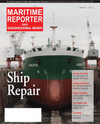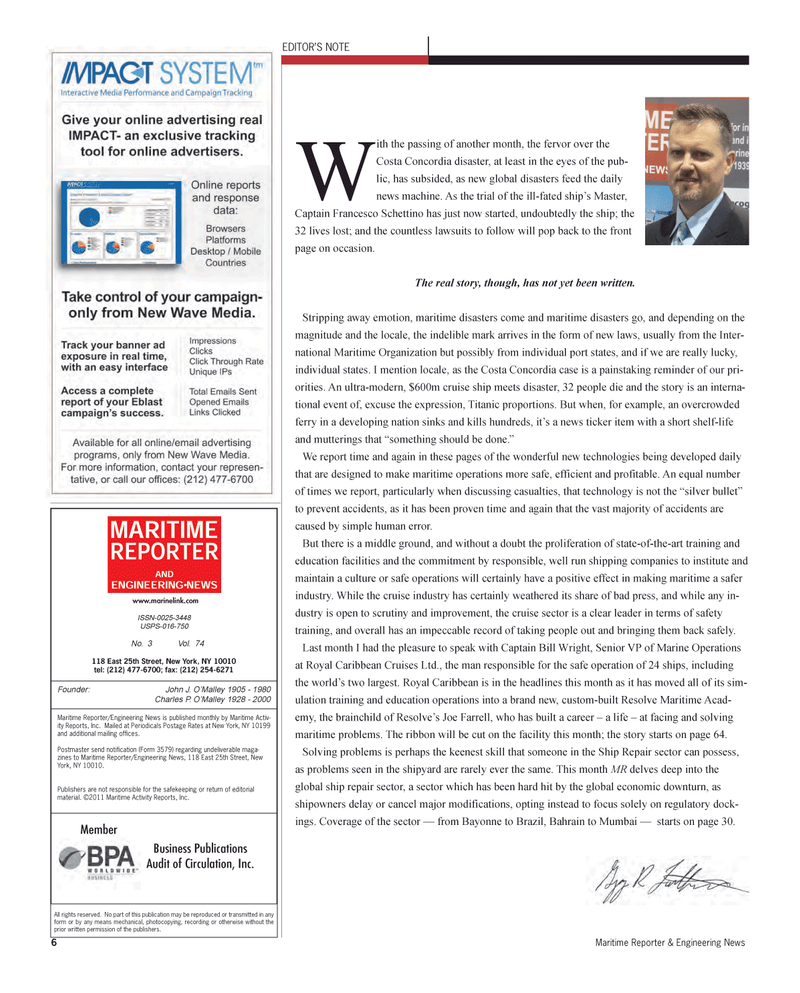
Page 6: of Maritime Reporter Magazine (March 2012)
The Ship Repair Edition
Read this page in Pdf, Flash or Html5 edition of March 2012 Maritime Reporter Magazine
6Maritime Reporter & Engineering News Founder: John J. O?Malley 1905 - 1980 Charles P. O?Malley 1928 - 2000 Maritime Reporter/Engineering News is published monthly by Maritime Activ- ity Reports, Inc. Mailed at Periodicals Postage Rates at New York, NY 10199 and additional mailing offices. Postmaster send notification (Form 3579) regarding undeliverable maga- zines to Maritime Reporter/Engineering News, 118 East 25th Street, New York, NY 10010. Publishers are not responsible for the safekeeping or return of editorial material. ©2011 Maritime Activity Reports, Inc. 118 East 25th Street, New York, NY 10010 tel: (212) 477-6700; fax: (212) 254-6271ISSN-0025-3448USPS-016-750No. 3Vol. 74 MemberBusiness Publications Audit of Circulation, Inc.www.marinelink.com MARITIMEREPORTER ANDENGINEERINGNEWS All rights reserved. No part of this publication may be reproduced or transmitted in any form or by any means mechanical, photocopying, recording or otherwise without the prior written permission of the publishers.EDITOR?S NOTEWith the passing of another month, the fervor over the Costa Concordia disaster, at least in the eyes of the pub- lic, has subsided, as new global disasters feed the daily news machine. As the trial of the ill-fated ship?s Master, Captain Francesco Schettino has just now started, undoubtedly the ship; the 32 lives lost; and the countless lawsuits to follow will pop back to the front page on occasion. The real story, though, has not yet been written. Stripping away emotion, maritime disasters come and maritime disasters go, and depending on the magnitude and the locale, the indelible mark arrives in the form of new laws, usually from the Inter- national Maritime Organization but possibly from individual port states, and if we are really lucky, individual states. I mention locale, as the Costa Concordia case is a painstaking reminder of our pri- orities. An ultra-modern, $600m cruise ship meets disaster, 32 people die and the story is an interna- tional event of, excuse the expression, Titanic proportions. But when, for example, an overcrowded ferry in a developing nation sinks and kills hundreds, it?s a news ticker item with a short shelf-life and mutterings that ?something should be done.? We report time and again in these pages of the wonderful new technologies being developed daily that are designed to make maritime operations more safe, efficient and profitable. An equal number of times we report, particularly when discussing casualties, that technology is not the ?silver bullet? to prevent accidents, as it has been proven time and again that the vast majority of accidents are caused by simple human error. But there is a middle ground, and without a doubt the proliferation of state-of-the-art training andeducation facilities and the commitment by responsible, well run shipping companies to institute and maintain a culture or safe operations will certainly have a positive effect in making maritime a safer industry. While the cruise industry has certainly weathered its share of bad press, and while any in- dustry is open to scrutiny and improvement, the cruise sector is a clear leader in terms of safety training, and overall has an impeccable record of taking people out and bringing them back safely. Last month I had the pleasure to speak with Captain Bill Wright, Senior VP of Marine Operations at Royal Caribbean Cruises Ltd., the man responsible for the safe operation of 24 ships, including the world?s two largest. Royal Caribbean is in the headlines this month as it has moved all of its sim- ulation training and education operations into a brand new, custom-built Resolve Maritime Acad- emy, the brainchild of Resolve?s Joe Farrell, who has built a career ? a life ? at facing and solving maritime problems. The ribbon will be cut on the facility this month; the story starts on page 64. Solving problems is perhaps the keenest skill that someone in the Ship Repair sector can possess, as problems seen in the shipyard are rarely ever the same. This month MRdelves deep into the global ship repair sector, a sector which has been hard hit by the global economic downturn, as shipowners delay or cancel major modifications, opting instead to focus solely on regulatory dock- ings. Coverage of the sector ? from Bayonne to Brazil, Bahrain to Mumbai ? starts on page 30. MR March 12 # 1 (1-8):MR Template 3/6/2012 9:24 AM Page 6

 5
5

 7
7
